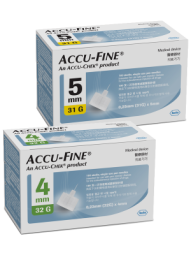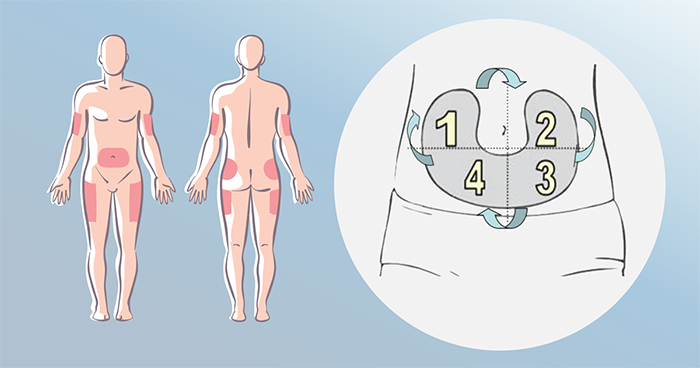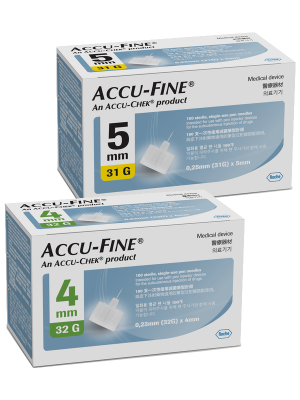
The insulin pen needles from the Accu-Fine product range allow for a gentle injection, as well as a safe and practical handling experience. Accu-Fine needles can be used with all common insulin pens. The needles are available in lengths of 4 and 5mm, and are suitable for all regardless of gender, age or BMI.
SHOP LAZADA (Accu-Fine Insulin Pen Needles 31G (0.25mm) x 5mm)
SHOP SHOPEE (Accu-Fine Insulin Pen Needles 31G (0.25mm) x 5mm)
SHOP LAZADA (Accu-Fine Insulin Pen Needles 32G (0.23mm) x 4mm)
SHOP SHOPEE (Accu-Fine Insulin Pen Needles 32G (0.23mm) x 4mm)
- Gentle injection: special cut for gentle insertion under the skin, special coating for gliding into the skin and thin wall for rapid insulin flow
- Dual protection: with two protective covers.
- Protective cap with dual function
- Sealed sterile protective cap
- Easy screwing and unscrewing of the needle
- Additional Protective cap
- Sterile needle tip ensures safe use
- Protective cap with dual function
- Suitable for everyone: regardless of gender, age or BMI
- Compatible: Fits on most insulin pens
- Minimizes the risk of intramuscular injections: which can be painful and also lead to the insulin reaching the blood too fast1,2
0.25mm (31G) x 5mm
0.23mm (32G) x 4 mm
NovoPen 4, NovoPen 5, NovoPen Echo, NovoPen 3, NovoPen Junior, FlexPen, InnoLet, Victoza Pen
Toujeo SoloStar, TactiPen, ClikSTAR, JuniorStar, SoloStar
KwikPen, HumaPen Savvio, HumaPen Luxura / Luxura HD
BerliPen Areo / Areo3
Byetta 5 mcg, Byetta 10 mcg
Autopen Classic, Autopen 24
Pendiq 2.0
For a complete list of compatible insulin pen injectors, please refer to this link
Each type of insulin is absorbed by the body at varying rates, i.e. the speed of efficacy also varies. In addition, the speed at which the insulin reaches the circulation from the different injection areas varies – depending on which area you choose:3
- Abdomen: Most rapid onset of action.
- Thigh: Delayed onset of action
- Buttocks/Hips: Slowest onset of action
Commonly, injections in the same site may cause lipodystrophy (a change in subcutaneous adipose tissue) which may result in erratic and unpredictable absorption of the insulin1. If possible, insulin should not be given more than once in the same cm² within one week. Make sure to change injection sites regularly; Inject insulin into different areas of the body and at different points in one area (clockwise within each area or from area to area).

How to inject
Using Accu-Fine needles does not require pinching of the skin. The needle can be inserted into the skin with one hand at an angle of 90 °. Count up to 10 during injection.
Change the needle after each injection
| Using the same needle repeatedly can lower the effect of the injection and lead to infections and lipodystrophy (change of the subcutaneous adipose tissue). For this reason, the needle must absolutely be changed after every use. |  |
Do not inject insulin over clothing
Injection over clothing is unhealthy, if blood or insulin leaks, it will be impossible to identify or clean it. Furthermore, clothes can remove the coating on the needle which allows for easier flow and gentle penetration. With the removal of the coating the needle can also be bent, making the injection more painful.
The correct needle and injection method
Only when using the correct needle and injection method can it be ensured that the insulin is injected into the subcutaneous tissue, and not into the muscle or dermis. The shorter the needle, the lower the risk of administering the injection into the muscle – which can be painful and also lead to the insulin reaching the blood too fast1,2. Furthermore, the injection is less painful, the thinner the needle is4.
The skin thickness for most adults is <3.5mm1. Below it is the subcutaneous tissue in which insulin injection is to be injected, whereby muscle is under that subcutaneous tissue. Injection into the muscle may be painful 1,2 and also accelerates the action of insulin.2 A shorter needle, such as the 4 and 5 mm Accu-Fine needles, can reduce this risk but still has a sufficient length to provide insulin to the subcutaneous tissue.
What is Gauge?
- The Gauge is a unit for the diameter of the needle.
- The higher the number of gauge, the smaller the needle diameter which has an impact on the user’s perception of pain5 and may motivate patients to comply better with their insulin regimens4.
References
1. Frid AH et al. New Insulin Delivery Recommendations Mayo Clin Proc 2016 91 9 1231 1255.
2. Thow JC, et al. Diabet. Med 1990;7: 600-602.
3. Gradel AKJ, Porsgaard T, Lykkesfeldt J, Seested T, Gram-Nielsen S, Kristensen NR, Refsgaard HHF. Factors Affecting the Absorption of Subcutaneously Administered Insulin: Effect on Variability. J Diabetes Res. 2018 Jul 4;2018:1205121.
4. Arendt Nielsen L et al. Pain following controlled cutaneous insertion of needles with different diameters. Somatosens Mot Res 2006; 23(1-2):37-43.
5. Præstmark KA et al: Pen needle design influences ease of insertion, pain, and skin trauma in subjects with type 2 diabetes. BMJ Open Diabetes Res Care. 2016 Dec 15; 4(1):e000266.

